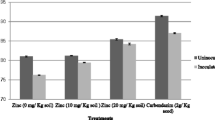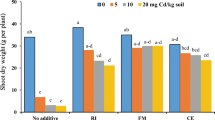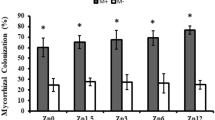Abstract
There is no information on the role of micronutrients on the mass production of the vesicular arbuscular mycorrhizal fungi. Hence zinc, copper and managanese at 4 different levels in Ruakura plant nutrient solution viz. 1/4, 1/2 and double the recommended level were studied to select the suitable level for mass production ofGlomus fasciculatum inoculum raised inChloris gayana (Rhodes grass) using perlite: soilrite mix (1:1 by volume). Percentage root colonization, extramatrical chlamydospore number and number of infective propagules per unit weight of the inoculum were maximum at half the recommended level i.e. 0·18, 0·04, 0·73 mM of Zn, Cu and Mn respectively.
Similar content being viewed by others
References
Alexander M 1965 Most probable number method for microbial population; inMethods of soil analysis part 2, chemiical and microbiological properties (ed.) C A Black (Wisconsin: Am. Soc. Agron.) pp 1467–1472
Black C A 1965Methods of soil analysis part II No. 9 in the series of ‘Agronomy’ (Wisconsin: Am. Soc. Agron. Inc.)
Gerdemann J W and Nicolson T H 1963 Spores of mycorrhizalEndogone species extracted from soil by wet sieving and decanting;Trans. Br. Mycol. Soc. 46 235–244
Gildon A and Tinker P B 1983 Interactions of vesicular arbuscular mycorrhizal infection and heavy metals in plants. I. The effect of heavy metals on the development of vesicular arbuscular mycorrhizas;New Phytol. 95 247–261
Hepper C M 1979 Germination and growth ofGlomus caledonius spores: The effects of inhibitors and nutrients;Soil Biol. Biochem. 11 269–277
McIlveen W D and Cole H Jr 1978 Influence of zinc on development of the endomycorrhizal fungusGlomus mosseae and its mediation of phosphorus uptake byGlycine max “Amsoy 71”;Agric. Environ. 4 245–256
Phillips J M and Hayman D S 1970 Improved procedures for clearing roots and staining parasitic and vesicular arbuscular mycorrhizal fungi for rapid assessment of infection;Trans. Br. Mycol. Soc. 55 158–161
Porter W M 1979 The ‘Most probable number’ method for enumerating infective propagules of vesicular arbuscular mycorrhizal fungi in soil;Aust. J. Soil. Res. 17 515–519
Smith G S, Johnston C M and Cornforth I S 1983 Comparison of nutrient solutions for growth of plants in sand culture;New Phytol. 94 537–548
Sreenivasa M N 1986 Inoculum production of the vesicular arbuscular mycorrhizal fungus,Glomus fasciculatum, Ph.D. Thesis, University of Agricultural Sciences, Bangalorer
Sreenivasa M N and Bagyaraj D J 1988Chloris gayana (Rhodes grass) a better host for mass production ofGlomus fasciculatum inoculum;Plant Soil (in Press)
Wood T 1984 Commercial pot culture inoculum production: Quality control and other headaches; inProc. 6th North Am. Conf on Mycorrhizae (ed.) R Molina (Forest Res. Lab. Pubs.) p 84
Author information
Authors and Affiliations
Rights and permissions
About this article
Cite this article
Sreenivasa, M.N., Bagyaraj, D.J. Suitable level of zinc, copper and manganese for mass production of the vesicular arbuscular mycorrhizal fungus,Glomus fasciculatum . Proc. Indian Acad. Sci. 98, 135–138 (1988). https://doi.org/10.1007/BF03053398
Received:
Revised:
Issue Date:
DOI: https://doi.org/10.1007/BF03053398




